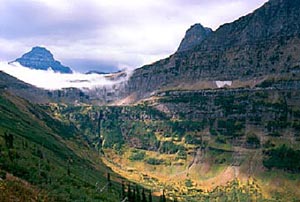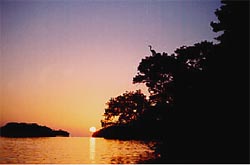Dec 26, 2025
Dec 26, 2025
Examples of How the Decision Footprint Works
 The Decision Footprint would be calculated by adding one's Consumption-decision Factor to their Child-creation Factor (again, a person does not 'decide' to be born, that decision was made by one's biological parents or individuals using the aid of a fertility clinic and should be reflected in their Decision Footprint calculation). If one is adopting a child, then the Adoption Factor is also added into the equation. After the first three factors are taken into account, a Life-support Protection Factor is subtracted to obtain one's Decision Footprint.
The Decision Footprint would be calculated by adding one's Consumption-decision Factor to their Child-creation Factor (again, a person does not 'decide' to be born, that decision was made by one's biological parents or individuals using the aid of a fertility clinic and should be reflected in their Decision Footprint calculation). If one is adopting a child, then the Adoption Factor is also added into the equation. After the first three factors are taken into account, a Life-support Protection Factor is subtracted to obtain one's Decision Footprint.
Example No. 1
The Decision Footprint of an American couple consuming at the average rate, creating two children, and a zero Life-support Protection Factor:
0 + 0 + 23.5 + 23.5 - 0 = 47 acres
0 (Consumption-decision Factor for the first parent: 23.5 - 23.5 equals 0)
+ 0 (Consumption-decision Factor for the second parent: 23.5 - 23.5 equals 0)
+ 23.5 (Child-creation Factor for the first child)
+ 23.5 (Child-creation Factor for the second child)
- 0 (Life-support Protection Factor)
Because of this couple's 'decisions', an additional 47 acres of wildlife habitat from around the world must be converted into human use'leaving less space for biodiversity and a further decline to a life-support system that's already overstressed.
Example No. 2
The Decision Footprint of an American couple consuming at the average rate, adopting two children in the U.S. and a zero Life-support Protection Factor:
0 + 0 + 0 + 0 - 0 = 0 acres
0 (Consumption-decision Factor for the first parent: 23.5 - 23.5 equals 0)
+ 0 (Consumption-decision Factor for the second parent: 23.5 - 23.5 equals 0)
+ 0 (Adoption Factor for the first child'the parents and child are from the same country so this factor is 0)
+ 0 (Adopted Factor for the second child'the parents and child are from the same country so this factor is 0)
- 0 (Life-support Protection Factor)
This couple's 'decisions' will have a neutral effect on the health of our life support system.
Example No. 3
The Decision Footprint of an American couple consuming at the average rate, adopting two children from a country with an average consumption rate of 12.6 acres, and a zero Life-support Protection Factor:
0 + 0 + 10.9 + 10.9 - 0 = 21.8 acres
0 (Consumption-decision Factor for the first parent: 23.5 - 23.5 equals 0)
+ 0 (Consumption-decision Factor for the second parent: 23.5 - 23.5 equals 0)
+ 10.9 (Adoption Factor for the first child: 23.5 - 12.6 equals 10.9)
+ 10.9 (Adoption Factor for the second child: 23.5 - 12.6 equals 10.9)
- 0 (Life-support Protection Factor)
Because of this couple's 'decisions', an additional 21.8 acres of wildlife habitat from around the world must be converted into human use'leaving less space for biodiversity and a further decline to a life-support system that's already overstressed.
Example No. 4
The Decision Footprint of an American couple consuming at the average rate, accomplishing nurturing alternatives (i.e. helping schools, churches, universities, nursing homes, civic groups, and educating fellow citizens in an effort to help all children around the world), and a zero Life-support Protection Factor:
0 + 0 - 0 = 0 acres
0 (Consumption-decision Factor for the first member of the couple: 23.5 - 23.5 equals 0)
+ 0 (Consumption-decision Factor for the second member of the couple: 23.5 - 23.5 equals 0)
- 0 (Life-support Protection Factor)
This couple's 'decisions' will have a neutral effect on the health of our life support system.
Example No. 5
The Decision Footprint of an American couple consuming at 'half' the average rate, creating two children, and a zero Life-support Protection Factor:
- 11.75 - 11.75 + 23.5 + 23.5 - 0 = 23.5 acres
- 11.75 (Consumption-decision Factor for the first parent: 11.75 - 23.5 equals a negative 11.75)
- 11.75 (Consumption-decision Factor for the second parent: 11.75 - 23.5 equals a negative 11.75)
+ 23.5 (Child-creation Factor for the first child)
+ 23.5 (Child-creation Factor for the second child)
- 0 (Life-support Protection Factor)
Because of this couple's 'decisions' (even at half the consumption rate), an additional 23.5 acres of wildlife habitat from around the world must be converted into human use'leaving less space for biodiversity and a further decline to a life-support system that's already overstressed.
Example No. 6
The Decision Footprint of an American couple consuming at 'half' the average rate, adopting two children in the U.S., and a zero Life-support Protection Factor:
- 11.75 - 11.75 + 0 + 0 - 0 = - 23.5 acres
- 11.75 (Consumption-decision Factor for the first parent: 11.75 ' 23.5 equals a negative 11.75)
- 11.75 (Consumption-decision Factor for the second parent: 11.75 - 23.5 equals a negative 11.75)
+ 0 (Adoption Factor for the first child'the parents and child are from the same country so this factor is 0)
+ 0 (Adoption Factor for the second child'the parents and child are from the same country so this factor is 0)
- 0 (Life-support Protection Factor)
Because of this couple's 'decisions', they are helping to restore 23.5 acres of wildlife habitat back into our life-support system.
Example No. 7
The Decision Footprint of an American couple consuming at 'half' the average rate, adopting two children from a country with an average consumption rate of 12.6 acres, and a zero Life-support Protection Factor:
- 11.75 - 11.75 + 10.9 + 10.9 - 0 = - 1.7 acres
- 11.75 (Consumption-decision Factor for the first parent: 11.75 - 23.5 equals a negative 11.75)
- 11.75 (Consumption-decision Factor for the second parent: 11.75 - 23.5 equals a negative 11.75)
+ 10.9 (Adoption Factor: 23.5 - 12.6 equals 10.9)
+ 10.9 (Adoption Factor: 23.5 - 12.6 equals 10.9)
- 0 (Life-support Protection Factor)
Because of this couple's 'decisions', they are helping to restore 1.7 acres of wildlife habitat back into our life-support system.
Example No. 8
The Decision Footprint of a 'Swiss' couple consuming at the average rate, adopting two children from the U.S., and a zero Life-support Protection Factor:
0 + 0 - 10.4 - 10.4 - 0 = - 20.8 acres
0 (Consumption-decision Factor for the first parent: 13.1 - 13.1 equals 0)
+ 0 (Consumption-decision Factor for the second parent: 13.1 - 13.1 equals 0)
- 10.4 (Adoption Factor for the first child: 13.1 - 23.5 equals a negative 10.4)
- 10.4 (Adoption Factor for the second child: 13.1 - 23.5 equals a negative 10.4)
- 0 (Life-support Protection Factor)
Because of this couple's 'decisions', they are helping to restore 20.8 acres of wildlife habitat back into our life-support system.
Example No. 9
The Decision Footprint of an 'Indian' (India) couple consuming at the average rate, creating two children, and a zero Life-support Protection Factor:
The average consumption rate for India is only 2 acres.6 However, it's reasonable to argue that if the 'average' citizen had the opportunity to 'decide' they would consume at least at the 12.6-acre rate (the minimum quality-of-life standard argued by this essay). Therefore, for this example, any consumption rate equal to or lower than 12.6 acres is assigned a zero for the Consumption-decision Factor. If an Indian couple consumes above the 12.6 rate, the excess would be a plus. If one 'intentionally' consumes below the 12.6 rate, the difference would be a negative. Again, one must remember that this is a 'Decision' Footprint calculation. As for the Child-creation Factor, it's reasonable to argue that the average child would consume at least at the 12.6-acre rate (if given the opportunity). Therefore, the 12.6 rate is used for the Child-creation Factor and it's separated into two parts (Consumption and Development Demand). Of course, access to contraceptive services, education, and equal rights for women are key elements as well. Therefore, it's an issue for the unique situation and conscience of each person calculating his or her own Decision Footprint.
0 + 0 + (2 + 10.6) + (2 + 10.6) - 0 = 4 acres of Consumption and 21.2 acres of Development Demand
0 (Consumption-decision Factor for the first parent)
+ 0 (Consumption-decision Factor for the second parent)
+ 2 (Child-creation Factor for the first child: Consumption)
+ 10.6 (Child-creation Factor for the first child: Development Demand)
+ 2 (Child-creation Factor for the second child: Consumption)
+ 10.6 (Child-creation Factor for the second child: Development Demand)
- 0 (Life-support Protection Factor)
Because of this couple's 'decisions' and/or 'lack of access' to the above elements, an additional 4 acres of Consumption and 21.2 acres of Development Demand for human use has been placed on wildlife habitat from around the world'leaving less space for biodiversity and a further decline to a life-support system that's already overstressed.
Example No. 10
The Decision Footprint of an 'Indian' (India) couple consuming up to 12.6 acres each (the minimum quality-of-life standard argued by this essay), adopting two children in India, and a zero Life-support Protection Factor:
0 + 0 + 0 + 0 - 0 = 0 acres
0 (Consumption-decision Factor for the first parent: 12.6 - 12.6 = 0)
+ 0 (Consumption-decision Factor for the second parent: 12.6 ' 12.6 = 0)
+ 0 (Adoption Factor for the first child'the parents and child are from the same country so this factor is 0)
+ 0 (Adopted Factor for the second child'the parents and child are from the same country so this factor is 0)
- 0 (Life-support Protection Factor)
This couple's 'decisions' will have a neutral effect on the health of our life support system.
Conclusion
 'Unless we can find some way to slow down population growth'to voluntarily optimize the population'the stresses and strains on the natural resources will be too great to bear.'
'Unless we can find some way to slow down population growth'to voluntarily optimize the population'the stresses and strains on the natural resources will be too great to bear.'
' Jane Goodall, Renowned Primatologist
'Humanity, in the desperate attempt to fit 8 billion or more people on the planet and give them a higher standard of living, is at risk of pushing the rest of life off the globe.'
' Edward O. Wilson, Professor Emeritus of Biology, Harvard University
'I have no doubt that the fundamental problem the planet faces is the enormous increase in the human population. You see it overrunning everywhere.'
' Sir David Attenborough, Renowned Wildlife Documentary Producer and Anthropologist
There are countless other examples and the author encourages the reader to calculate their own Decision Footprint. The above examples clearly show how difficult it is for individuals who create children to have a restorative effect upon the planet's overstressed life-support system (even when consuming at half the average rate in the U.S.)'the same life-support system that the children they created will depend upon in the future. Yet couples consuming at the average (or at the minimum quality-of-life standard) and choosing adoption in their own country (or some other nurturing alternative) are already life-support system neutral with their decisions; and members of this group, living in wealthy countries, can easily achieve a restorative effect by reducing their consumption rate and increasing their Life-support Protection Factor.
As for adopting children outside one's country, the examples show it's difficult to achieve a 'significant' restorative effect when bringing children into a high-consumption society (even when the parents consume at half the average rate). However, one can achieve a significant restorative effect when adopting a child from a high-consumption country into a modest-consumption society. Furthermore, since the life-support system is in crisis, it's imperative that all of humanity work together to increase our restorative decisions and not be satisfied with neutrality when consuming above the minimum standard. Neutrality will not heal our injured life-support system. Therefore, the best way to accomplish this task is to lower our population and consumption, and no decision puts more pressure on our overstressed life-support system than the decision to create a child. Nor is it reasonable to believe that a reduction in consumption alone will protect or restore our life-support system. For the time being, the Life-support Protection Factor still provides a method for all of us (especially citizens in wealthy countries) to improve upon our Decision Footprint from decisions made in the past.
As for the future, if we don't change our reproductive and consumptive behavior, our life-support system will continue to decay, and humanity's long-term physical and spiritual health will continue to decay as well. We need to look up into the night sky and ponder the following questions:
 Galileo's words are as profound today as they were in the 17th century:
Galileo's words are as profound today as they were in the 17th century:
"I do not feel obliged to believe that the same God who has endowed us with sense, reason, and intellect has intended us to forgo their use."
Because they hold the key for positive change; religious leaders, teachers, scientists, students, responsible citizens, and environmental/conservation groups need to reflect upon humanity's reproductive and consumptive behavior. Also, because of their knowledge and position within society, they bear the greatest responsibility for setting the example and providing leadership. Yes, overpopulation and reducing consumption are unpopular topics in a finite world. However, intellectual and spiritual maturity demands that one warn humanity even in the face of great adversity. But take heart, as more individuals and organizations muster the courage to join the chorus, it will only inspire others to speak out'creating a wave of support and positive change.
Therefore, the author challenges every citizen around the world to reflect upon his or her Decision Footprint and to conduct additional research and discourse in this area.
References
1. World Wildlife Fund, 'Living Planet Report 2004', www.worldwildlife.org/about/lpr2004.pdf, page 28, U.S. ecological footprint is 9.5 hectares or 23.4745 acres (rounded to 23.5). One hectare is equal to 2.471 acres. The Global Footprint Network provided the consumption-footprint data for the above reference and another version of data is located at www.footprintnetwork.org/gfn_sub.php?content=footprint_acres. (Because of rounding, the data for the two references may be slightly different.)
2. www.myfootprint.org, this consumption-footprint calculator is provided by Redefining Progress on the web at www.rprogress.org. Another version of the calculator is on the web at www.mec.ca/Apps/ecoCalc/ecoCalc.jsp
3. World Wildlife Fund, 'Living Planet Report 2004', www.worldwildlife.org/about/lpr2004.pdf, page 28, U.S. ecological footprint is 9.5 hectares or 23.4745 acres (rounded to 23.5). One hectare is equal to 2.471 acres.
4. World Wildlife Fund, 'Living Planet Report 2004', www.worldwildlife.org/about/lpr2004.pdf, page 30, Western Europe's ecological footprint is 5.1 hectares or 12.6021 acres (rounded to 12.6). One hectare is equal to 2.471 acres.
5. World Wildlife Fund, 'Living Planet Report 2004', www.worldwildlife.org/about/lpr2004.pdf, page 30, Switzerland's ecological footprint is 5.3 hectares or 13.0963 acres (rounded to 13.1). One hectare is equal to 2.471 acres.
6. World Wildlife Fund, 'Living Planet Report 2004', www.worldwildlife.org/about/lpr2004.pdf, page 26, India's ecological footprint is .8 hectares or 1.9768 acres (rounded to 2). One hectare is equal to 2.471 acres.
Earth/Moon Photograph: NASA. All other photographs: Copyright ' William C. Gladish. Essay: Copyright - 2005 & 2006 by William C. Gladish. All Rights Reserved. The Decision Footprint concept and the first version of this essay were presented in October 2005 at the annual conference of the North American Association for Environmental Education. The author wishes to thank all the friends, associates, and scholars from around the world that provided feedback on this essay. For publishing requests, please contact the director at the following email address: director@ACriticalDecision.org. Thank you
previous
02-Apr-2006
More by : William C. Gladish